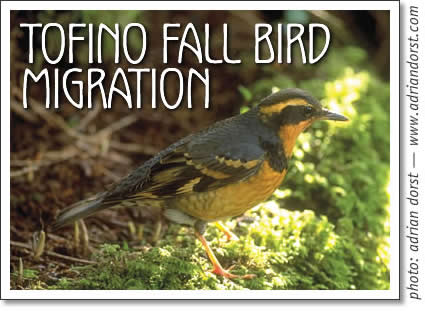
Tofino Fall Bird Migration
by George Bradd, Tofino

In Tofino this time of year fall bird migration is in full swing, and birdwatchers can expect the unexpected surprises. During late August and September 2004 Tofino recorded several rare bird species including Long-billed Curlew, Buff-breasted Sandpiper, Brown Pelican and a Xantus’s Murrelet!Migration is the movement of birds between two separate locations. Birds that live in the northern temperate regions of the world are strongly migratory. In the northern temperate zones like Tofino, the numbers of hours of light per day, the air and water temperatures and food supplies affect the time of migration.
In Tofino we have bird migration of both altitudinal and latitudinal kinds. The pretty orange and blue-grey Varied Thrush is now descending from the mountain forests to the outer coast where it will winter. The Red-naped Sapsucker moves down from the mountains to the outer coast in September and is another example of a species that migrates up and down in altitude.
Now during salmon season our coastal Bald Eagles are migrating to the salmon spawning rivers, in order to feed on the readily available dead fish.
Bald Eagles will gather in large numbers on an inland river to feed in fall, and later will disperse after the fish are gone. Not all eagles will leave, some of them will remain here. Not all birds of a species will leave or migrate some often stay one year and then leave the next.
The Rufous Hummingbird that breeds in Tofino has a long way to go to Peru, and the adult males leave first, then the females and young birds follow later. Some species migrate in sexually segregated flocks, mated pairs of birds do not always leave together at the same time.
North-south migration is not always on the same route in both spring and fall. Migration is not a simple reversal of following the same path both ways north and south. The Baird’s Sandpiper is seen in Tofino only in fall migration, because in spring it heads north from the high Andes up the center of North America. In late August/ September the Baird’s Sandpiper appears on our sandy beaches for just a few weeks time. Their large size enables them to wade sometimes chest deep in the shallow pools of water on the local beaches of Tofino, much like their winter home of shallow fresh water ponds in the high Andes. The Baird’s Sandpiper migration is sometimes called a “loop migration”.
Birds migrating south from Tofino will trickle south rather then arriving in a large spring “wave” of migration. The necessity of being the first on a breeding territory for spring is not present in the fall, so birds are in no rush to beat each other to the wintering grounds.
Fall migration 2004 in Tofino has been marked by several significant flights of migrating birds being “grounded” by low pressure, fog and rain. Large numbers of passarines occurred on several occasions giving impressive numbers of Yellow, Orange-crowned and Townsend’s Warblers all waiting for high pressure and no fog before they head south. Tofino beaches recently have been hit by waves of hundreds of Savannnah Sparrows that were grounded by bad weather. These small birds are thought to migrate at night to avoid predation and maximize the amount of time available to feed during daylight hours. Bird species always migrate before their food supply runs out, and migration routes often coincide with available food supplies in other places.
Bird identification in fall migration can be difficult. At this time immature birds are mixed with adults and adult plumages in different individuals of the same species will be different depending upon the stage of molt.
Adult plumages in fall will vary from partial breeding or complete breeding plumage to eclipse plumage or partial or full winter plumage. Young birds often look very different from adults in fall. A fall flock with mixed species of warblers is enough to keep anybody on their toes. In fall birds are not singing vigorously and so bird identification by sound which is so useful during spring, can’t help us in fall migration. Because bird sound is so essential in locating birds and identifying them, many birds in fall slip through unnoticed because they are silent.
Tofino sightings of Brown Pelican and Xantus’s Murrelet, both normally found far south, may be due to warm ocean currents bringing these birds north. Xantus’s Murrelet, a small black and white seabird, is normally found off the Mexican coast north to Monterrey California. Ocean temperatures of 14.3 °C. were measured offshore Tofino the same day this rare seabird was seen. I would expect to see a Brown Pelican flying over surfers in California, but on September 15th a pelican flew over Tofino surfers!
Fall migration is an exciting time of the year to birdwatch in Tofino, offering the opportunity to challenge your identification skills with juvenile plumages or the possiblity of finding a rare bird like the Xantus’s Murrelet.
George Bradd operates Just Birding, a Tofino company specialising in birdwatching tours. For more information, visit his website at www.justbirding.com
Tofino Birdwatching Articles
- Tofino Birding: Brown Pelicans in Tofino August 2006
- Falcons of Tofino Nov. 2004
- Fall Bird Migration Oct. 2004
- Fall Bird Migration Oct. 2004
- Rare Birds in Tofino Aug. 2004
- The Windbirds are Back! May 2002
- Ospreys in Tofino Sep. 2005
- Tofino Birdwatching Oct. 2003
- Tofino Shorebird Festival 04 May 2004
- Watch Birds! June 2002
- Who gives a hoot? Tofino Birding: Owls Feb. 2005
- Winds from the South… May 2004
- The Watchers: Birders in Tofino April 2009
Tofino Time Magazine October 2004
- Events in Tofino
- Tide Table for Tofino
- Paddling Basics
- Tofino Fall Bird Migration
- Bats of Clayoquot Sound
- Strawberry Isle Scuttlebutt
- Tofino artist Lyn DesRosier
- Tofino artist Michelle Foley
- Essay: The Briefcase
- Gardening in October
- Tofino Profile: Mary Martin
- Tofino Horoscope
- Community Directory
tofino | tofino time | activities | accommodation | events | directory
maps | travel | food | art & artists | photos | horoscope | tides
search | magazine | issues | articles | advertising | contact us
hosted in tofino by tofino.net & studio tofino
© 2002-2014 copyright Tofino Time Magazine in Tofino Canada
Tofino birding guide George Bradd writes about the Fall bird migration in Tofino in Tofino Time magazine in 2004.
